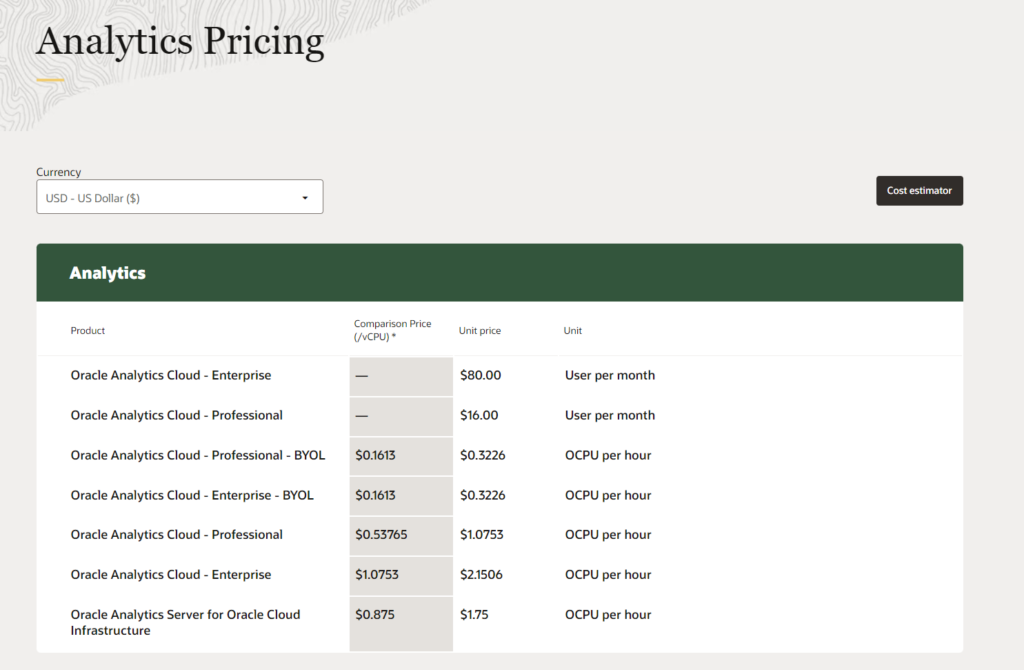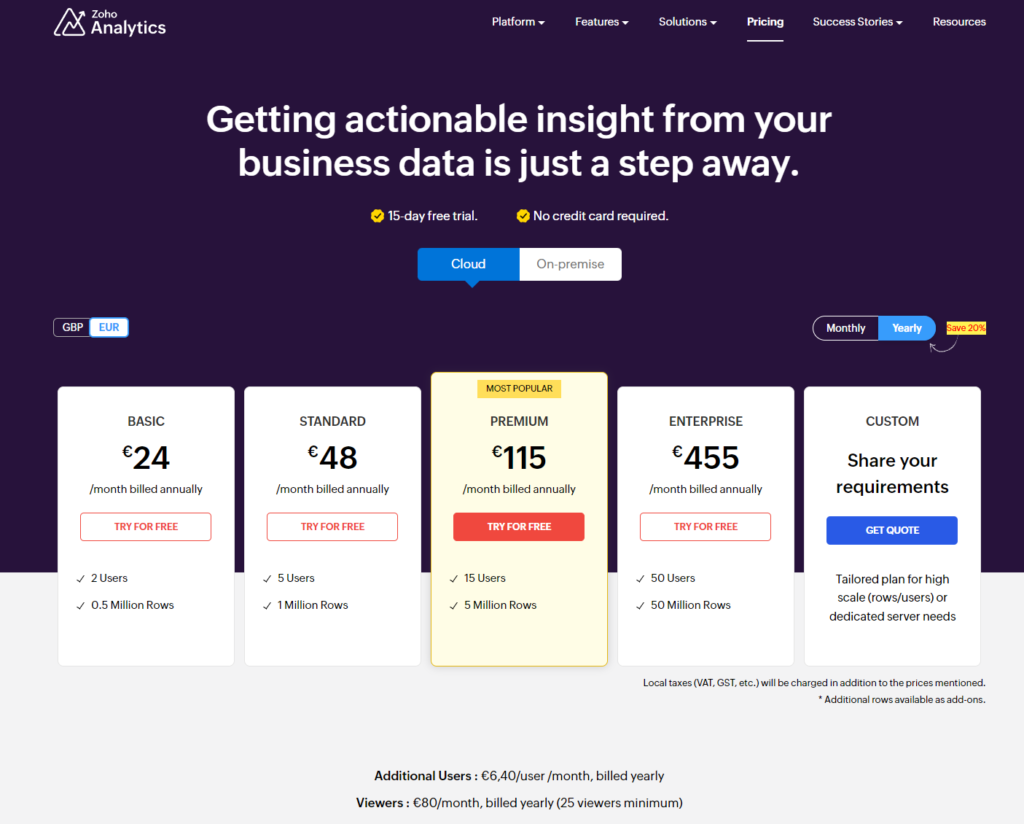Hello there! If you’re on the hunt for the analytics tool that’s just right for you, you’re in the right place. Today, we’re diving into a head-to-head comparison between two giants in the analytics world: Oracle Analytics Cloud (OAC) and Zoho Analytics. Whether you’re a data-driven decision-maker, a marketing maven, or just someone who geeks out over graphs and charts, we’ve got the lowdown to help you make the best choice for your needs. So, let’s cut through the clutter and get straight to the point, shall we?
| Oracle Analytics Cloud | Zoho Analytics |
|---|---|
 |  |
| G2 Score -4.0 out of 5 | G2 Score -4.3 out of 5 |
| TrustRadius Score -8.1 out of 10 | TrustRadius Score -8.1 out of 10 |
Ease of Use and User Interface
In the vast ocean of data, the ease with which you can navigate your analytics tool is like the compass guiding your ship. Here’s how Oracle Analytics Cloud and Zoho Analytics measure up when it comes to user-friendliness and interface design.
Oracle Analytics Cloud: The Sophisticated Voyager
Oracle Analytics Cloud is like a state-of-the-art cruise ship equipped with every imaginable navigational aid. It’s designed for depth and breadth, offering a powerful suite of analytics capabilities. With OAC, you’re not just getting a tool; you’re getting a comprehensive platform that can handle complex data analysis, predictive modeling, and more.
The catch? Well, commanding a vessel this sophisticated requires some know-how. New users might find OAC’s extensive capabilities a bit daunting at first. The platform is geared towards users who aren’t strangers to data analytics, which means there’s a bit of a learning curve to becoming a seasoned captain of the OAC ship. Fear not, though—Oracle provides a treasure trove of documentation, tutorials, and community forums to help you navigate these waters.
Zoho Analytics: The Agile Explorer
Zoho Analytics, on the other hand, is like a swift sailboat that’s ready to catch the wind. It offers a streamlined, user-friendly interface that makes data analysis accessible, even to those who may not have a deep background in data science. Zoho’s emphasis on simplicity doesn’t mean it’s basic, though. The platform provides a robust set of tools for creating dashboards, generating reports, and analyzing data with ease.
What makes Zoho Analytics stand out is its agility. The platform is designed for quick setup and ease of use, allowing users to jump straight into exploring their data without a steep learning curve. It’s an ideal choice for small to medium-sized businesses or teams that need to democratize data analytics and make insights accessible across the board.
Pricing Models
The pricing structures of OAC and Zoho Analytics are reflective of their target markets and the breadth of functionalities they offer, each tailored to different organizational needs and budget constraints.
Oracle Analytics Cloud: Tailored for Enterprise Needs

OAC’s pricing model is designed to accommodate the comprehensive and advanced analytics needs of large enterprises. OAC employs a subscription-based model where the cost is determined by several factors, including data volume, number of users, and level of access to advanced features such as predictive analytics and machine learning capabilities. This model provides the flexibility to scale services up or down based on organizational needs.
Given the customizable nature of OAC to fit specific business requirements, Oracle often requires potential customers to engage directly for pricing inquiries. This ensures a tailored solution but necessitates direct contact for accurate pricing information. The investment in OAC reflects its enterprise-grade capabilities and is justified by the value it delivers through comprehensive data analytics. Organizations should consider not only the direct costs but also the broader ROI from implementing such a robust analytics platform.
Zoho Analytics: Accessible and Transparent Pricing

In contrast, Zoho Analytics offers a more straightforward and accessible pricing model, catering to small and medium-sized businesses as well as departments within larger organizations. Zoho Analytics features clear, tiered pricing plans available on its website, with options ranging from a free basic plan for small teams to higher-tier plans that support larger user bases and greater data processing needs. This transparency helps businesses of all sizes predict their investment and select a plan that best suits their budget and analytics requirements.
Zoho’s pricing model is designed to scale with the growth of your business, offering the flexibility to upgrade plans as your data analytics needs evolve. This approach supports long-term financial planning and ensures that businesses can extend their analytics capabilities without unforeseen costs.
Data Integration and Management
As we sail further into the comparison of Oracle Analytics Cloud (OAC) and Zoho Analytics, understanding how each platform facilitates the integration and management of data is crucial. After all, the richness of insights you can derive largely depends on how effectively your analytics tool can handle data from various sources.
Oracle Analytics Cloud: Navigating Through Complex Data Seas
OAC is akin to a large, well-equipped vessel designed to traverse the complex seas of enterprise data. It boasts extensive data integration capabilities, enabling organizations to bring together data from a multitude of sources, including on-premises databases, cloud applications, and third-party services. This comprehensive approach ensures that businesses can create a unified view of their data landscape, essential for in-depth analysis and strategic decision-making.
Beyond integration, OAC offers powerful data management features, allowing users to cleanse, enrich, and transform data directly within the platform. This capability ensures that data is analysis-ready, facilitating more accurate and meaningful insights. Given its broad data integration and sophisticated management tools, OAC is particularly suited for large organizations with complex data ecosystems. Its ability to handle vast volumes of data from various sources makes it a formidable choice for businesses that demand depth and breadth in their analytics endeavors.
Zoho Analytics: Agile Data Integration for Swift Insights
Zoho Analytics, much like a nimble schooner, offers a streamlined approach to data integration that emphasizes ease of use and speed. It enables businesses to connect to a variety of data sources, including popular cloud services, databases, and online applications. Zoho’s focus is on making data integration as effortless as possible, allowing users to quickly bring together data for analysis.
Zoho Analytics provides intuitive tools for managing data once it’s integrated, including options for blending data from different sources and creating custom datasets. These features are designed with non-technical users in mind, ensuring that businesses can focus on deriving insights rather than wrestling with data.
With its emphasis on ease of use and quick setup, Zoho Analytics is particularly appealing to small and medium-sized businesses (SMBs) or agile teams within larger organizations. It offers the flexibility and speed needed for businesses that require rapid insights to respond to changing market conditions.
Scalability and Performance
Understanding how each platform scales and performs under various conditions is crucial for ensuring that your analytics tool can support your organization’s growth and evolving needs.
Oracle Analytics Cloud: Engineered for High Demands
OAC is designed with scalability and high performance in mind, particularly suited for large enterprises with extensive data analytics requirements. Built on Oracle’s robust cloud infrastructure, OAC offers exceptional scalability options. It can easily accommodate the growing amount of data and an increasing number of users, making it an ideal choice for organizations that anticipate significant growth or have variable analytics demands.
OAC is optimized for performance, even when handling complex queries across large datasets. Its architecture is designed to ensure that analytics operations remain fast and efficient, providing timely insights to users across the organization, regardless of the data volume or complexity involved.
Zoho Analytics: Agile and Flexible for Growing Businesses
Zoho Analytics, while also scalable, is particularly noted for its agility and flexibility, catering well to small and medium-sized businesses as well as departments within larger organizations. Zoho Analytics allows for flexible scaling, making it straightforward for businesses to adjust their analytics capabilities as they grow.
This platform is adept at supporting an increasing number of users and handling larger data volumes, ensuring that businesses can continue to derive insights without performance hiccups. Known for its responsive performance, Zoho Analytics ensures that users can quickly access the insights they need. The platform is designed to deliver fast data processing and real-time analytics, which is crucial for businesses that rely on timely data to make informed decisions.

Related: Check out our free SEO suite

Integration Ecosystem
Delving deeper into the Integration Ecosystem of Oracle Analytics Cloud (OAC) and Zoho Analytics, we find crucial distinctions that can significantly influence an organization’s decision based on its existing technology stack, workflow requirements, and future integration needs.
Oracle Analytics Cloud: Extensive Enterprise Integration
OAC benefits from being part of Oracle’s comprehensive suite of cloud applications and services. This positioning offers deep integration capabilities with other Oracle products, which can be a significant advantage for businesses already invested in Oracle’s ecosystem. OAC is designed to integrate seamlessly with a wide range of Oracle applications, including Oracle Cloud ERP, Oracle Cloud HCM, Oracle Database, and more. This integration facilitates streamlined workflows and data consistency across Oracle environments.
Beyond Oracle products, OAC supports integration with various third-party data sources and applications. This is achieved through direct connectors, REST APIs, and data upload options, ensuring that OAC can serve as a central analytics hub for diverse data landscapes. For unique or complex integration needs, OAC provides robust APIs and developer tools that allow for custom integration solutions to be developed, offering flexibility for tailored data ecosystems.
Zoho Analytics: Agile and Broad Third-Party Integration
Zoho Analytics emphasizes easy integration with a wide array of business applications and data sources, making it an adaptable choice for organizations using multiple cloud services and on-premises software. Zoho Analytics offers direct integration with over 500+ business applications, including popular CRM, ERP, HRM systems, and social media platforms. This extensive support facilitates a unified view of data from disparate sources.
For businesses using Zoho’s suite of applications, Zoho Analytics provides an added advantage of native integration, enabling seamless analytics across Zoho CRM, Zoho Books, Zoho Projects, and other Zoho applications. Zoho Analytics is designed with a focus on user-friendliness, offering straightforward tools for integrating and synchronizing data without the need for extensive IT involvement. Its self-service approach empowers users to set up and manage integrations with minimal effort.
Conclusion
Concluding our in-depth exploration of Oracle Analytics Cloud (OAC) and Zoho Analytics, we’ve traversed through several key areas that significantly influence the selection of the right analytics tool for your organization. From the ease of use and user interface, data integration and management, scalability and performance, to the pricing models and the critical aspect of the integration ecosystem, each platform has demonstrated unique strengths tailored to different organizational needs and priorities.
READ NEXT:
- MicroStrategy vs Amplitude: The Best Analytics Tool for You
- Oracle Analytics Cloud vs Woopra: The Best Analytics Tool for You
- MicroStrategy vs Tableau: The Best Analytics Tool for You
- Hotjar vs Mouseflow: The Best Analytics Tool for You
- “GoSquared vs Tableau: The Best Analytics Tool for You”
- 11 Marketing Analytics Tools to Elevate Your Data-Driven Strategies
- 29+ Digital Analytics Software to Skyrocket Your Digital ROI






















Comments are closed.